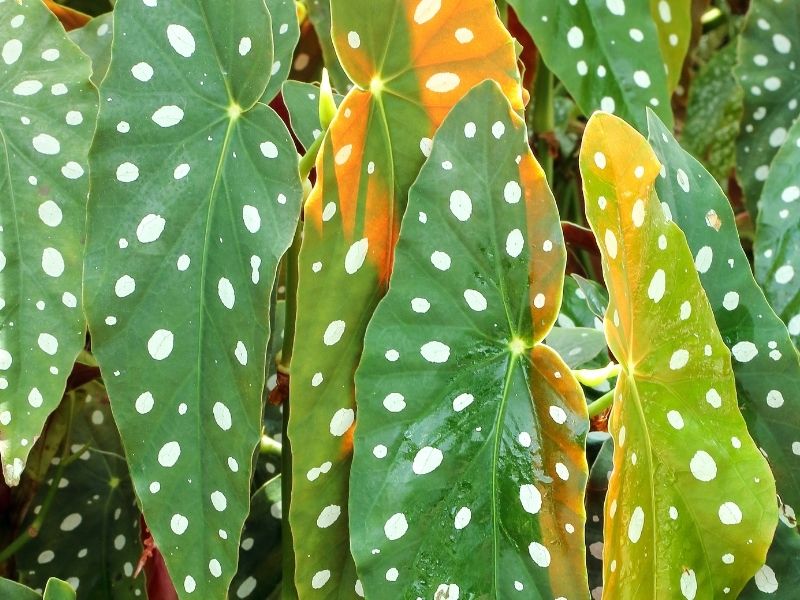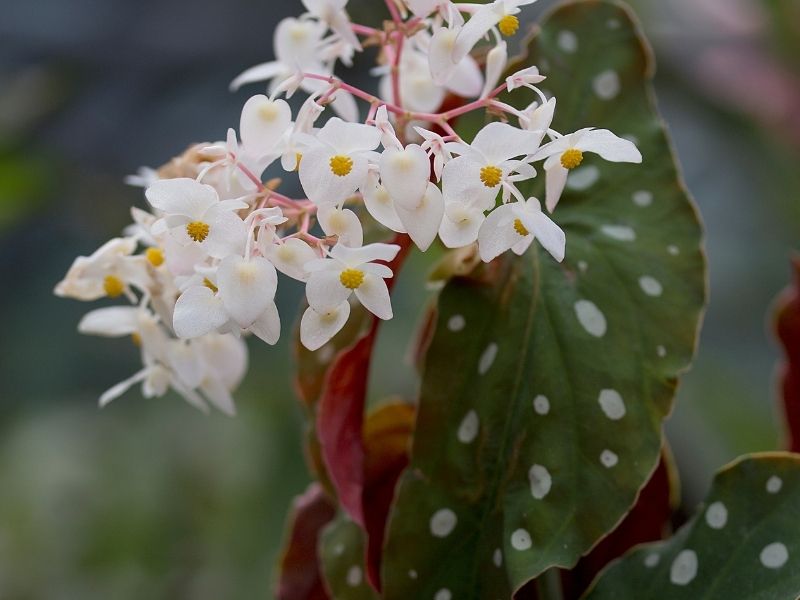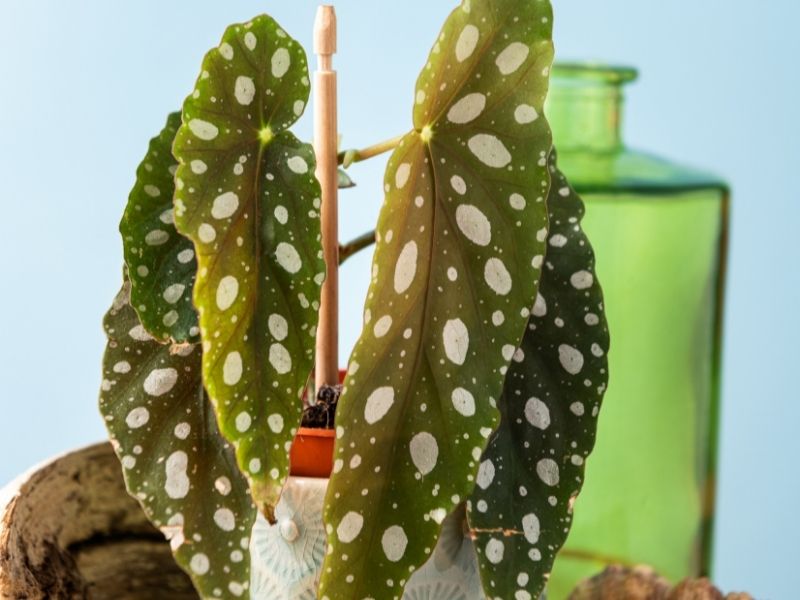The beautiful begonia maculata — also known as the polka dot begonia — is one of the most stunning houseplants you can find!
It’s also one of my personal favorite plants in my burgeoning collection! When I first bought it, I fell in love with a photo of it online at my favorite local nursery.
I love its beautiful dark green leaves and the contrast of the silvery polka dots on them, and how whimsical this houseplant looks — almost like a plant you’d find in a Dr. Seuss book.
Already in love with begonia maculate before I bought it, it continued to impress me.
When my plant shop delivered it, I was delighted to see it was blooming!
It came with a dozen white flowers, and ever since then, it’s continued to surprise me in all the best of ways, putting out impressive new growth at a continuous rate, despite entering the fall and winter season.
In fact, my begonia maculata seems to somehow know whenever I need a pick-me-up, and it’s always put out new leaves just as I’m starting to feel down about something.
I remember coming home from a particularly stressful road trip and being surprised at a brand new leaf I hadn’t known was coming looking huge and healthy after just a few short days away!
In fact, I’ve had this plant for only about two months and it’s already bloomed twice and put out two brand new leaves. It’s also nearly doubled in height!
It’s quite low maintenance and I couldn’t be happier with my beautiful polka dot begonia.
Table of Contents
Where Can I Buy a Begonia Maculata Plant?

I always recommend buying plants from your local nursery or grower when possible, as you’ll be able to inspect the health of the plant directly.
Plus, you can avoid any damage that might be done during shipping.
However, if you can’t find a begonia maculata (also known as begonia maculata wightii) anywhere local, I recommend turning to Amazon — you can find one here!
What Does Begonia Maculata Look Like?

As you can imagine from its nickname (polka dot begonia) the begonia maculata is well-known for its polka-dotted leaves that are said to resemble angel wings.
The top sides of the olive green leaves are marked with silvery-white polka dots. Meanwhile, the underside of the plant has beautiful red undersides.
As if this wasn’t striking enough, the begonia maculata is also a flowering plant. It blooms frequently (mine is even blooming well into November!) with beautiful white flowers with yellow centers.
Typically, a new leaf will emerge from the same place once the flowers have dropped.
Begonia maculata is part of the cane begonia family which are one of the easier ones to take care of, so named for their bamboo-like stems.
Where Does Begonia Maculata Come From?

The stunning begonia maculata was discovered in Brazil, in the states of Espírito Santo and Rio de Janeiro.
However, that’s not the only place it was found. It has also been discovered as a native plant in Mexico, South Africa, Madagascar, several countries in Central America, and some countries in Asia as well.
The begonia maculata’s wide geographical range suggests that it may have been imported between countries during the colonial exploration period, likely by Portuguese and Spanish colonists.
Is Begonia Maculata Toxic?

There are many species of begonia (well over 1,000!). In general, begonia species are not toxic to humans (according to the National Capital Poison Center).
However, they are very toxic to pets, especially the root systems which contain something called “insoluble oxalates” which can result in death for dogs and cats.
While the spotted begonia maculata is beautiful, I don’t recommend owning it if you have a curious pet.
Always check the toxicity of plants before adding them to your collection if you have pets!
Begonia Maculata Care Tips

Light Requirements
The begonia maculata prefers bright indirect light.
Seems like an oxymoron? Don’t fret!
This is the exact language that used to have me spinning out and deciding not to own any plants, but it’s pretty simple.
To understand this, let’s remember that many of the houseplants we know and love once came from dense tropical forests, shrouded by canopies.
The light they adapted to was filtered through the layers of canopy above it, so the leaves evolved to enjoy the dappled sunlight.
While you can’t exactly recreate this in an apartment (although I’m not above trying),
Bright indirect light means that a room gets bright light (from either a west or east-facing window, or indirectly (mediated through a light curtain or window) from a south-facing window.
Meanwhile, direct sunlight means that the plant directly receives rays from the sun during a large portion of the day.
Begonia maculata can actually do fairly well in low light environments thanks to their red-backed leaves, which maximize light intake.
However, low light environments will definitely hamper growth and blossoming, so keep that in mind. Low light isn’t a dealbreaker, but you won’t maximize their potential!
Watering
Begonia maculata plants can be prone to root rot, which is a result of overwatering. Once root rot has set in, it is really hard to save a plant.
The most key thing is to make sure you have a well-draining pot. This means either keeping it in its nursery pot or repotting it in a pot with drainage holes.
The begonia maculata likes to maintain a fairly even moisture level, not getting too dry or staying too moist. Mine generally likes to be watered once a week.
However, a better rule of thumb is to check the moisture level with your finger — if it’s dry about one inch down (about to your first knuckle), you can go ahead and water it.
When watering, soak the soil until the water flows freely out of the drainage holes, then let the water drain out completely before you place it back in any saucer or decorative pot.
While this may seem counterintuitive when I just told you to avoid overwatering, this is key to ensuring that the roots get the moisture they need. More water + less frequency + good drainage = happy plants.
Note: when watering, do not get the leaves wet! The leaves are prone to fungus and mildew. It’s also not recommended to mist the leaves.
Humidity

As plants native to countries like Brazil with tropical climates, as you can imagine, the polka dot begonia enjoys a humid environment!
There are several ways to achieve higher humidity levels for an indoor plant, such as using a humidifier or a pebble tray set over some water. Another way is to cluster it with other plants, who will provide more humidity.
For what it’s worth, my begonia maculata is doing great without a humidifier or pebble tray, and it’s just on my coffee table not near any other plants!
Soil Type
Begonia maculata likes well-draining soil, like an aroid mix.
What does that mean?
It’s recommended to use potting mix interspersed with some sort of chunky aspects like perlite or wood chips that will allow for better drainage.
If you don’t want to make your own aroid mix, I suggest this pre-mixed aroid potting blend.
Repotting
The begonia maculata should be repotted about once a year.
Generally, they can handle being rootbound quite well, but if you want to maximize growth, an annual repotting will serve them well and ensure good soil and root health.
Pruning

Begonia maculata tends to grow upwards — and larger than you might think when you first look at it!
When given appropriate supports, it can reach a height of up to 5 feet or 1.5 meters. However, this also means that it can get quite leggy!
When we say a plant is leggy, it means that there is far more stem than there are leaves, leading to a stripped-down and bare-looking plant, as opposed to a lush and bushy plant.
Pruning your begonia maculata during the growing season (spring and summer) is a great way to ensure it will grow full and beautiful for years to come, while still gaining height.
Propagation
Because the begonia maculata benefits so much from pruning, this is the perfect plant to try propagating!
Don’t throw out the leaves you prune on your polka dot begonia. Rather, place the leaf and stem cuttings in a glass of water in the sun and wait for roots to form!
Be sure that you include the nodes when you prune the begonia if you are trying to propagate it. Otherwise, it won’t take root.
Once roots have formed, you can plant your begonia maculata cuttings in some potting mix and watch them grow. Voila, new plants!
Fertilizing
Begonia maculata benefits from frequent fertilization as well, which encourages more flowering and more frequent leaf growth.
Fertilize once every 2-4 weeks, though you may opt to take a break in the winter, depending on your indoor growing conditions.
Polka Dot Begonia Maculata Common Problems

Root Rot
As mentioned above in the watering section, begonia maculata can experience root rot if it is overwatered and not given sufficient drainage.
You can tell your begonia has root rot when the stem is blackened and the leaves darken. The only way to salvage it is to repot the plant, removing any dead roots and hoping you can salvage some healthy roots.
Yellow Leaves
Yellow leaves are another problem your begonia maculata can face if you overwater it.
This is a less serious problem than root rot as you can typically just prune the affected leaves. You likely will not need to repot unless the issue is being caused by poor drainage.
Brown Tips
Brown leaf tips on a begonia maculata indicate the opposite problem – it’s too dry! Increase the frequency of watering if you have not been watering it sufficiently.
If you think you’ve been watering it sufficiently, likely the problem is a lack of humidity.
If you don’t have a humidifier, consider moving your begonia to a location with high humidity such as the bathroom.
However, the very tips of my begonia maculata are a tiny bit browned and “crispy,” for lack of a better word.
It seems to be happy and in good health, so keep in mind that a slight browning at the very tips is not a big deal.
Pests
All houseplants can be affected by pests. A few of the most common pests are spider mites, mealybugs, whiteflies, and thrips.
Mealybugs and whiteflies tend to attack this lovely polka dot plant more often than spider mites and other pests.
Keep an eye on it for any indication of pests so that you can address any pest infestations ASAP.

Allison is a recovering brown thumb turned helicopter plant mom. She lives in California and is currently working on turning her one-bedroom Oakland apartment into an indoor jungle.